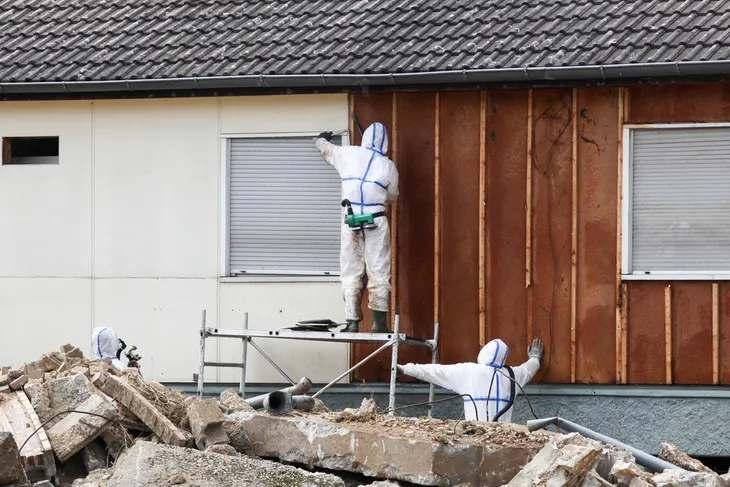- Asbestos fibers are resistant to heat, fire, and chemicals, making it an attractive product for many industries, especially construction.
- Unfortunately, breathing in asbestos fibers can wreak havoc on your health, and for this reason, it’s heavily regulated today.
- Be on the lookout for the warning signs of asbestos exposure and contact your doctor if symptoms develop.
Most people have at least heard of asbestos. These resilient fibers are known to be resistant to heat, corrosion, and fire, making them an attractive material for commercial and industrial applications. In fact, it was so common between 1900 and 1980 that 30 million tons of asbestos were used. Unfortunately, the health complications of asbestos exposure weren’t known then.
Thankfully, the federal government started regulating the use of asbestos and asbestos products in the 1970s, and handling the products today is heavily regulated. However, asbestos still exists, especially in older homes built during that time. So, it’s important to understand what it is, how it affects your health, and the warning signs that you’ve been exposed to asbestos. Here’s what you need to know about asbestos exposure.
What Is Asbestos?
In short, asbestos is a natural mineral product. The National Cancer Institute explains that asbestos is “the name given to six minerals that occur naturally in the environment as bundles of fibers that can be separated into thin, durable threads for use in commercial and industrial applications.”
It’s widely known to be resistant to heat, fire, and chemicals, and it doesn’t conduct electricity. All of these factors are what made it an attractive material across many industries, especially construction. The Mayo Clinic says asbestos was often used in the past in cement, in some floor tiles, and to insulate buildings.
How Does Asbestos Affect Your health?
Asbestos exposure can wreak havoc on your health, causing mild to severe symptoms. The American Lung Association explains that when you inhale asbestos fibers, they can cause inflammation and scarring of your lung tissues.
Prolonged asbestos exposure can cause a condition called asbestosis, a type of pulmonary fibrosis. The source also notes that asbestos exposure often occurs in the workplace, so it’s also sometimes referred to as an occupational lung disease.
Who’s at Risk of Asbestos Exposure?
According to the Mayo Clinic, most people who develop asbestosis got it from exposure in the workplace before the government started regulating the use of asbestos. The source says individuals who worked in mining, milling, manufacturing, and installation or removal of asbestos products (before 1970) have the greatest risk of adverse health effects. Some of these occupations include:
- Building construction workers
- Electricians
- Refinery and mill workers
- Asbestos miners
- Workers removing asbestos insulation around steam pipes in older buildings
The source also notes that secondhand exposure is also possible. If exposed workers carry asbestos fibers home on clothing, their household members are at risk of exposure. Individuals that lived close to the mines may have also been exposed due to asbestos fibers in the air. The good news is that handling asbestos products is strictly regulated today and getting asbestosis is very unlikely if you follow the proper safety procedures.
Warning Signs of Asbestos Exposure in the Lungs
Unfortunately, there aren’t usually immediate signs of asbestos exposure. Symptoms usually appear many years after initial exposure and once the disease develops. The Mesothelioma Center says the following are possible warning signs of asbestos exposure in the lungs:
- Shortness of breath
- Dry cough or wheezing
- Crackling sound when breathing
- Chest pain or tightness
- Respiratory problems
- Pleural effusion, which is an accumulation of fluid in the space surrounding a lung
- Pleural plaques
- Pleural thickening
- Asbestosis
Warning Signs of Asbestos Exposure in Other Parts of the Body
While asbestos exposure often affects the lungs, the Mesothelioma Center says it can also cause symptoms in other parts of your body too. Be on the lookout for these other warning signs:
- Loss of appetite
- Weight loss
- Abdominal swelling
- Abdominal or pelvic pain
- Hernia
- Bowel obstruction
- Difficulty swallowing
- Hoarseness
- Fingertips and toes that appear wider and rounder than usual, known as clubbing
What Causes Asbestosis?
So, we know that inhaling asbestos can wreak havoc in your body but why does this occur exactly? The Mayo Clinic explains when you’re exposed to high levels of asbestos dust over a long time, airborne fibers can become lodged within your alveoli. These are “the tiny sacs inside your lungs where oxygen is exchanged for carbon dioxide in your blood.” Once the asbestos fibers become lodged, they can cause irritation and scar lung tissue. Eventually, this can cause the lungs to become stiff, making it hard to breathe.
As asbestosis advances, more lung tissue becomes scarred. Over time, this can cause your lungs to become so stiff that they don’t expand and contract normally. The source also notes that smoking can “increase the retention of asbestos fibers in the lungs.” As a result, this may cause a faster progression of the disease.
When to See a Doctor
The Mayo Clinic says asbestosis increases your risk of lung cancer. Smoking or having a history of smoking can increase your risk further. Although rare, the source says malignant mesothelioma, which is a cancer of the tissue around the lung, can develop many years after asbestos exposure.
If you’re showing signs of asbestosis, contact your doctor. If you’re not currently showing symptoms but you have a history of asbestos exposure then you should also contact your doctor to discuss your risk of asbestosis and what you can do to stay healthy.
How Is Asbestosis Diagnosed?
To diagnose asbestosis, your doctor will likely start by reviewing your medical history and exposure history, and perform a physical exam. Your doctor will also likely require imaging testing (such as a chest X-ray or CT scan) to see if there is scarring in your lungs.
The American Lung Association also says your doctor will likely perform breathing tests too. All of this information can help your doctor diagnose asbestosis, determine how severe it is, and how well your lungs are functioning.
How to Treat Asbestosis
Unfortunately, damage caused by asbestos can’t be reversed. However, the American Lung Association says there are steps that can help slow the progression of the disease and help manage your symptoms. For starters, it’s vital to avoid further exposure to asbestos and other harmful irritants like smoking. If you smoke, your doctor will likely advise you to quit and if you don’t smoke, don’t start.
The following are possible treatment options:
- Oxygen therapy involves transferring oxygen from a tank through a tube that fits into the nostrils or with the help of a mask.
- Pulmonary rehabilitation involves an exercise program that helps you maintain healthy activity levels.
- In severe cases, surgery may be necessary and you may be referred to a lung transplant specialist.
How to Manage the Symptoms
Since the damage can’t be reversed, part of your treatment plan will be taking steps to help manage your symptoms. While your doctor will help create a plan, the American Lung Association says there are things you can do to help keep yourself healthy too. One thing you can do is make sure you’re eating a well-balanced diet and drinking plenty of water.
The source also notes, getting good quality sleep every night and taking short rests during the day (when needed) can also keep you healthy. Getting regular exercise is also important but don’t overexert yourself. The source also says you should do your best to avoid breathing harmful pollutants that can trigger shortness of breath, such as secondhand smoke, traffic fumes, smog, and aerosol sprays. Staying indoors when air pollution is severe and pollen counts are high may also help.
What Is the Outlook?
As mentioned, damage caused by asbestosis can’t be reversed. The goal of your treatment plan is to slow the progression and manage your symptoms. The American Lung Association says when you have asbestosis, you may get sick more often and as the disease progresses, you’ll need to make lifestyle changes to prevent shortness of breath.
In severe cases when asbestosis is advanced, hospitalization may be necessary to help you breathe. It’s important to work with your medical team and do what you can to stay healthy for as long as possible.
 Shutterstock/Peera_stockfoto
Shutterstock/Peera_stockfotoHow to Prevent Exposure to Asbestos
The best way to prevent asbestosis is to prevent exposure to asbestos. Luckily, the U.S. has federal laws that require employers (in industries that work with asbestos and asbestos products) to take special safety precautions. Workers should always use the protective equipment provided by their employers and follow all the proper safety procedures to prevent exposure.
Additionally, many homes and other buildings built before 1970 still have materials that contain asbestos. However, the Mayo Clinic says there isn’t a risk of exposure as long as the asbestos is “enclosed and undisturbed.” When the material becomes damaged, there’s a risk of asbestos fibers being released into the air and then inhaled. The source says you should always have asbestos products inspected, repaired, or removed by a trained and licensed professional.














